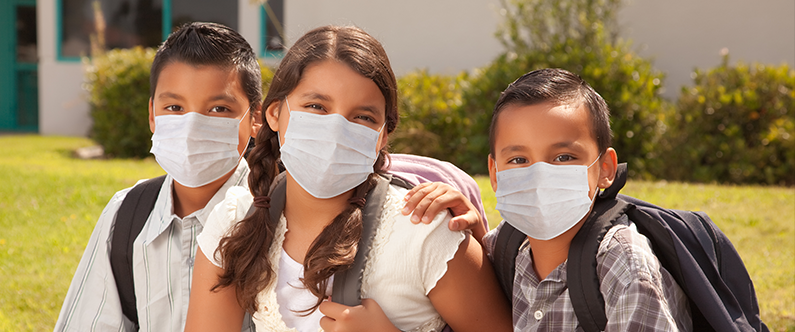COVID-19 in Children
 Applying safety measures to protect against the COVID-19 virus can be difficult for children
Applying safety measures to protect against the COVID-19 virus can be difficult for children
Children, including toddlers and babies, can develop COVID-19. However, most of them will have no symptoms or experience mild symptoms (e.g., low-grade fever, fatigue, and cough). Some children can have severe complications, but this is infrequent.
Health conditions that increase a child’s risk of serious illness with COVID-19
Children with underlying health conditions may be at an increased risk for severe illness following infection with SARS-CoV-2. These health conditions are:
- Obesity
- Diabetes
- Asthma
- Congenital heart disease
- Genetic conditions
- Conditions affecting the nervous system or metabolism.
Preventing the spread of COVID-19
While studies published when the pandemic started suggested that children do not contribute much to the spread of COVID-19, more recent studies indicate that children can spread the virus to others. Teach children everyday actions to reduce spread:
- Cough or sneeze in bent elbow or tissue (not in the hands)
- Count until 20 while washing hands
- Wear a mask (for children older than 2 years)
- Try to maintain a physical distance of at least one meter from others
- Avoid close contact with someone who is sick.

COVID-19 vaccine to protect children
COVID-19 vaccines are highly effective at preventing severe illness, hospitalizations, and death due to COVID-19. The Ministry of Public Health (MoPH) recommends that children aged 5 to 17 years receive the two-dose Pfizer/BioNTech COVID-19 vaccine. Children aged 12 to 17 years may be vaccinated with the standard Pfizer/BioNTech vaccine and children aged 5 to 11 years should receive Pfizer/BioNTech’s pediatric vaccine, contains a lower dose.
Tips to enjoy family outings safely
- Outdoor activities and playdates are safer than indoor ones
- Avoid places that are crowded or poorly ventilated
- Children younger than 2 years old and people who cannot wear a mask should limit their visits to people who are not vaccinated or whose vaccination status is unknown
- Keep a distance between children and other people in public spaces.
Minimizing risk with babysitters or childcare personnel
Parents who need babysitters or childcare personnel to take care of their children can minimize the risk of infection by following these steps:
- Choose a babysitter who has minimal exposure to other people besides your family (e.g., a live-in babysitter)
- Limit the number of babysitters used to provide care
- Ensure that the babysitter understands the need to practice physical distancing
- Assure that the babysitter recognizes the importance to quarantine if he/she feels sick or has been exposed to a COVID-19 positive person
- Practice frequent handwashing throughout the day, especially before eating.
Applying safety measures to protect against the COVID-19 virus can be difficult for children. Being patient and showing them what to do as role models will help children follow our lead.
Sources: Ministry of Public Health-Qatar | Center for Disease Control and Prevention (CDC) | Harvard Health Publishing | Mayo Clinic
Contributors: Dr. Karima Chaabna, Dr. Sohaila Cheema, and Dr. Amit Abraham
Editor: Mr. John Hayward